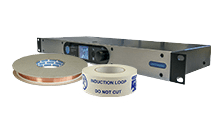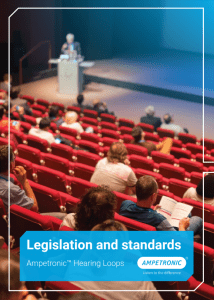Ampetronic hearing loop systems help to safeguard the rights of people who experience hearing loss and ensure performance to Standard e.g. IEC 62489-1 and IEC 60118-4.
To ensure hearing aid users have access to suitable assistive listening technologies, many countries have developed legislation and adopted standards specifying acceptable access levels for how well the chosen systems should perform. If installed and used correctly, hearing loop systems will consistently meet or exceed performance standards IEC 62489-1 and IEC 60118-4 set out by the International Electrotechnical Commission (IEC).
Disability access
For people utilising assistive listening technologies, and loops in particular, user protection is typically provided in the form of anti-discrimination laws and building regulations.
CRPD is an international agreement protecting and promoting human rights of disabled people throughout the world. This agreement recognises that everyone is of equal value, has the right to make their own decisions, and should be treated with fairness, dignity, and respect. This convention describes steps which governments must take, to ensure disabled people enjoy equal human rights, including:
- equality before the law without discrimination
- an inclusive education and a decent standard of living
- support to participate in society and live in the community
- accessible physical environments and information
Following The Universal Declaration of Human Rights, adopted by the United Nations (UN) General Assembly on 10 December 1948, the UN developed the ‘UN Convention on the Rights of People with Disabilities’ CRPD 2006. The UN convention has resulted in many countries developing their own legislation, specifying how the rights of people with disabilities will be protected. In Europe, the European Economic and Social Committee have developed a Directive on the European Accessibility Act 2016.
In the UK there are several codes of practice which support equality of access for those with disabilities including:
- UK Equality Act
The Equality Act 2010 replaces the anti-discrimination laws, including the Disability Discrimination Act or DDA, with a single Act which simplifies and strengthens the law to tackle discrimination and inequality affecting people with ‘protected characteristics’ covering age, sex, race and disability. The guide to the section pertaining to disability access can be seen here and makes mention of hearing loops.“Service providers are required to make changes, where needed, to improve service for disabled customers or potential customers. There is a legal requirement to make reasonable changes to the way things are done (such as changing a policy), to the built environment (such as making changes to the structure to improve access) and to provide auxiliary aids and services (such as providing information in an accessible format, an induction loop for customers with hearing aids, special computer software or additional staff support when using a service).” - Building Regulations Part M: Access to and use of buildings, volume 2: buildings other than dwellings
The UK building regulations inform architects and builders about the requirements for new buildings and alterations to existing buildings, and include disability access. The regulations mention induction loops in reference to reception desks, performance and discussion areas and prominent use of signage to inform the hard of hearing of their presence.“Any reception point is provided with a hearing enhancement system, e.g. an induction loop.”“In order to obtain the full benefit of attending public performances or taking part in discussions, a person with impaired hearing needs to receive a signal that is amplified in both volume and signal to noise ratio. The three systems commonly used to provide this enhanced level of sound are induction loops, infrared and radio.”“Provision for a hearing enhancement system is installed in rooms and spaces designed for meetings, lectures, classes, performances, spectator sport of films, and at service or reception counters when they are situated in noisy areas or they are behind glazed screens.The presence of an induction loop or infrared hearing enhancement system is indicated by the standard symbol.” - British Standard BS 8300
Describes how to create an accessible and inclusive environment for disabled people and details the requirements of how buildings should be designed, constructed and maintained.
BS8300:2:2018 gives practical guidance on how the requirements of Part M can be incorporated into the built environment. For architects, AV specifiers, and installers the standard states, amongst other things, what type of assistive listening and loop systems should be specified given the needs of the end user e.g. meeting/lecture rooms, theatres, cinemas, performance areas, lifts, help points, counters and reception areas.
In addition, the standard specifies the need for clear signage to indicate where assistive listening and induction loops are available. - IEC TR 63079 / BS 7594 Code of practice for hearing loop systems (HLS)
This code of practice gives advice on all aspects of the loop provision, from the microphone inputs, the loop itself to the signage and routine testing of the installation.
“The performance of induction loop systems is specified in IEC 60118-4, whereas this document gives recommendations and guidance for their design, planning, installation, testing, operation and maintenance.”
“Except for home systems sold as a complete kit, the engagement of a skilled system designer is advisable and is considered to be essential whenever large or complex installations are involved.”
A summary of relevant legislation used by different countries can be seen here:
Performance standards
In addition to access legislation guaranteeing the availability of assistive listening solutions, the International Electrotechnical Commission (IEC) has developed a set of criteria which specifies the minimum acceptable standard at which any system should perform eg. IEC 62489-1 and IEC 60118-4
IEC 60118-4
In terms of hearing loops, the criteria are set out in Standard IEC-60118-4 and include:
- low magnetic background noise for intelligibility and comfort
- correct field strength setting a suitable signal level
- even field strength for consistency of signal
- flat frequency response essential to maintain intelligibility
IEC 62489-1
The IEC have also published IEC 62489-1 Standard, which stipulates how performance of an amplifier is measured.
"IEC 62489-1… applies to the components of audio-frequency induction loop systems for assisted hearing. It may also be applied to such systems used for other purposes, as far as it is applicable. This standard is intended to encourage accurate and uniform presentation of manufacturers' specifications, which can be verified by standardized methods of measurement. It is intended for type testing.“
Caution: Some manufacturers can confusingly provide misleading information regarding performance parameters including:
- Current
IEC 62489-1 requires a measurement of capability with real signals and real loads. It is no longer acceptable to state currents for instantaneous peaks, as ‘peak to peak’ measurements, capability at very low frequencies, or capability with unrealistic (non-inductive / short circuit) loads. - Voltage
The standard requires a voltage measurement when the unit is actually delivering a meaningful signal into a real loop. Not specified as peak to peak, instantaneous, or measured at low loads or with continuous sinewave signals as is sometimes the case today. - Area coverage
IEC 62489-1 includes a way to state area coverage for an area or perimeter loop, for 1:1 and 3:1 aspect ratio rooms. While area coverage is a very complex affair, and values in reality will be much lower in the presence of metal structures using MultiLoop™ solutions, the reference method does make for a fair comparison between equipment.
To ensure you are providing a genuine benefit always purchase amplifiers that are IEC 62489-1 compliant.
The important characteristics for a hearing loop driver as defined by IEC 62489-1 are shown in the table below.
| wdt_ID | Clause | Title | Description | Ampetronic Definition, Units | Explanation |
|---|---|---|---|---|---|
| 1 | - | Intended application | Describes the desired purpose and function of the system | Product literature | |
| 2 | 5.2.1 | Rated power supply voltage | AC or DC supply voltage | Power W | Input voltage and power / current consumption at quiescent, nominal (pink noise) and full sine |
| 3 | 5.4.1 | Rated source impedance | As connected to signal inputs | Input impedance Ω | Input impedance of the amplifier also provided so that suitable source impedance can be used. Range stated for microphones. |
| 4 | 5.4.2 | Rated source e.m.f | As connected to signal inputs | Sensitivity dBu | Minimum voltage applied to the input to achieve AGC (at maximum input gain) and so capable of full output current |
| 5 | 5.4.3 | Rated Load | Load used for measurements against this standard | Derived from 5.4.11: R = Ωdc, L=µH at 1.6kHz | 1:1 square load as defined in 5.4.11 with minimum resistance to satisfy amplifier |
| 6 | 5.4.4 | Rated temperature limited output current | Indefinite delivery in known conditions – load, ambient temperature, and cooling etc. | Continuous pink noise ARMS | Indefinite delivery of Pink noise - provided the ventilation and ambient are controlled |
| 7 | 5.4.5 | Rated time for delivery of rated distortion limited output current | Time for which rated distortion-limited output current can be delivered to the rated load without unacceptable effects. >30s | Time (s) | Minimum time for delivery of ‘Current’ figure - provided the ventilation and ambient are controlled - at least 1 minute |
| 8 | 5.4.6 | Rated THD of output current | THD level not exceeded when delivering the rated maximum (distortion-limited) current to the rated load. | THD+N % | Overall distortion running ‘Current’ at 1kHz |
| 9 | 5.4.7 | Max (distortion limited) output current | 1kHz sine delivered for at least 10s into the rated load without exceeding 5.4.6 | Current ARMS | 1kHz output design current – figure used to design systems |
| 10 | 5.4.8 | Compliance voltage | Average maximum VRMS when delivering pink noise to the rated load | Voltage VRMS | Voltage capability when loading an amplifier with a real signal – figure used to design systems |
| 11 | 5.4.9 | Noise / SnR | Equivalent input noise with no signal applied | SnR | |
| 12 | 5.4.10 | Magnetic field strength | At 1.4m offset from loop plane (rated load) | - | Not necessarily 0dB - parameter used to define rated load |
| 13 | 5.4.11 | Loop dimensions (for 1:1 and 3:1 loops) | Where 400mA/m is obtained with 1kHz at 1.4m - linear dimensions | Area coverage | Applied with no metal loss in practical installation, although we use 1.6kHz to ensure Voltage capability |
| 14 | 5.4.12 | Frequency response | The variation of output current into the rated load with frequency, no AGC | Frequency Response | Usually provided as -3dB points as per standard convention, but sometimes also variation 100Hz-5kHz |
| 15 | 5.4.13 | Automatic gain control and compression | The steady-state relationship between output current and input source e.m.f. | Dynamic range dB | Control range of AGC above ‘Sensitivity’ before overload is achieved |
| 16 | 5.4.14 | Phase error of quadrature networks for phased arrays | The maximum deviation from 90°of the phase angle between loop currents | Phase error ° | Maximum offset value and frequency of error across the range 100Hz – 5kHz |
| 17 | 5.4.15 | Installation | Advice to ensure consideration of ventilation, safety, EMC, cabling etc | Installation | Comprehensive details provided in installation manual. |
| 18 | 5.4.16 | Physical Characteristics | dimensions, temperature & humidity limits | Physical | Summary provided in technical specification |
At Ampetronic™ we believe the following criteria are also essential for delivering acceptable system performance:
- input audio to separate signal from noise
- acceptable coverage
- clear signage, no user request necessary
- training, monitoring, maintenance
Facility operators can find themselves in an actionable position, if there is no service provision that is of a genuine benefit to users Installation must be fit for purpose. Measurable performance of a hearing loop system is defined, in international standard IEC 60118-4.
If you have any questions regarding the provision of an effective and compliant system or the standards IEC 62489-1 and IEC 60118-4 please contact us on +44 (0) 1636 610 062 or email support@ampetronic.com
For alternative assistive listening solutions please visit https://av.ampetronic.com




